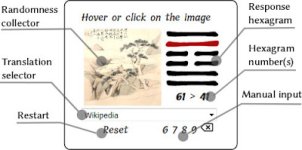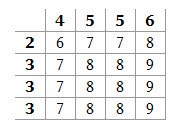Clarity,
Office 17622,
PO Box 6945,
London.
W1A 6US
United Kingdom
Phone/ Voicemail:
+44 (0)20 3287 3053 (UK)
+1 (561) 459-4758 (US).

Exactly the same way they affect coins or yarrow stalks. (Or in other words - no-one knows.)And how are questions / intentions able to affect it?

That was here! Unfortunately, I used the Wilhelm/Baynes translation, and someone reported the copyright infringement. I received a very scary email, promised them I hadn't made any money from it, and took the script down in a hurry!Also, per the 16 marbles, there was a site that used that method some time ago that I liked to use because of it supposed approximation to the yarrow sticks. But it was java based and either the site owner took it down or a browser "upgrade" did (maybe both).
Just in case you don't know, those odds are heavily in favor of hexagram 2 as the relating hexagram. You'll get 2-relating a lot more often than anything else.Also, per the 16 marbles, there was a site that used that method some time ago that I liked to use because of it supposed approximation to the yarrow sticks. But it was java based and either the site owner took it down or a browser "upgrade" did (maybe both).
It's good to know that the yijing sites that I currently use right now also aim for the yarrow method.
 ).
).I appreciate this and will be asking many questions, please stand byGosh! I didn't know I was famous
Yes I did the GPT4 experiment too, you'll find the prompt on GH as well but I've done some modification online, let me know if your are interested and I'll update the prompt on GH as well. The most current version is Ji Yi, it uses yarrow stalks (sixteen marbles) probability distribution but follows its own process as it casts first the entire hexagram and then, for each line, determines if it's a changing line according to the yarrow stalks probabilities. You can see it done in the response.py script. Alas OpenAI only allows access to those with a premium account.
I'm happy to see someone is interested! Feel free to ask, sharing will be a pleasure for me.
I think they're the same odds, but that's off the top of my head.Are you saying the odds for the marble method, or the yarrow, or both?
Never heard of a 2 coin method.

Or approximately the same... the maths is beyond me for yarrow. @remod ?I think they're the same odds, but that's off the top of my head.
Hilary knows I can't resistOr approximately the same... the maths is beyond me for yarrow. @remod ?

Why ? For when you don't have 3 coins available ? Anyway never heard of it till now.
2 coins
In addition to reproducing the yarrow probabilities, this method has all the advantages of the three coin method: practical, simple, and no special equipment required. Of course, you can still opt to light a candle or burn incense, or use special Chinese coins - whatever helps your focus on what yowww.onlineclarity.co.uk
Well, I just maybe thought in my own mind that yarrow was the way to go because that's the way it was done in the beginning? But I only read this. Maybe it really started with kiln-dried tortoise shells. And make turtle soup?Why ? For when you don't have 3 coins available ? Anyway never heard of it till now.
-- and solid __, it's not a Yijing reading I don't think.)I never put together all the sources but from what I've gathered, yarrow stalks-based divination was in use for a long time before using coins, sometimes as an alternative method to confirm/enlight oracles got with scapulomancy (using tortoise shells or ox bones). The exact method used, however, has been lost to us.I think I read somewhere that yarrow stalks aren't actually the oldest? Could be mistaken.
Spot on, at least as far as I know. Either that predominance of changing yang (and hence Hexagram 2 as relating) reveals a deep understanding of the asymmetric nature of yin and yang, or else it shows a blithe disregard for statistics. Take your pick.So, it's true that yarrow stalks were in use before coins but it is also true that the yarrow stalks method we know is more recent than the three coins.
Yes, an explanation like that that makes sense could convince me to use it, but otherwise...well, I don't know. Explanations either way would be good, but maybe they don't exist. Meanwhile I'll just keep my head in the sand; it's reasonably happy there.Either that predominance of changing yang (and hence Hexagram 2 as relating) reveals a deep understanding of the asymmetric nature of yin and yang
I'm not clear what you mean. The probability of not getting any 1 in six throws is 33.49% (which is a little bit higher than 1/3).Well, yes. Seen from the perspective that it went on from turtle shell- to plant- and to coin divination... why not?
Add.: maybe except that humans did those ceremonies contra algorithms based on randomized algorithms - again based on theories concerning randomness.
The theory will go that when you throw a die six times, one of those six throws will result in one eye. Try it out...
1. six throws: Oh, 1 eye occurred
2. six throws again: Oh, 1 eye occurred three times
3. six throws again: Oh - Hmmm. No occurrence of 1 eye - and so on.
This is the formula given, roughly, by the French counterpart to the Italian Leonardo da Vinci, Blaise Pascal. If you ask me, Pascal made it as a finger pointer to what in many cases could be expected, but suppose the case where there was no occurrence of 1 eye through those six throws, and in an allegorical way compared with what you achieved at this very moment where you urgently needed advice?
Clarity,
Office 17622,
PO Box 6945,
London.
W1A 6US
United Kingdom
Phone/ Voicemail:
+44 (0)20 3287 3053 (UK)
+1 (561) 459-4758 (US).